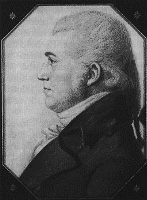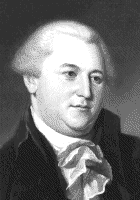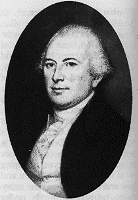![]()
 Richard Bassett
Richard Bassett
Delaware
Image: The Baltimore Museum of Art
Bassett (Basset) was born in Cecil County, MD., in April 1745. After his tavern-keeper father deserted his mother, he was reared by a relative, Peter Lawson, from whom he later inherited Bohemia Manor (MD.) estate. He read for the law at Philadelphia and in 1770 received a license to practice in Dover, DE. He prospered as a lawyer and planter, and eventually came to own not only Bohemia Manor, but homes in Dover and Wilmington as well.
During the Revolution, Bassett captained a troop of Dover cavalry militia and served on the Delaware council of safety. Subsequently, he participated in Delaware's constitutional convention and sat in both the upper and lower houses of the legislature. In 1786 he represented his state in the Annapolis Convention.
At the U.S. Constitutional Convention the next year, Bassett attended diligently but made no speeches, served on no committees, and cast no critical votes. Like several other delegates of estimable reputation and talent, he allowed others to make the major steps.
Bassett subsequently went on to a bright career in the state and federal governments. In the Delaware ratifying convention, he joined in the 30-0 vote for the Constitution. Subsequently, in the years 1789-93, he served in the U.S. Senate. In that capacity, he voted in favor of the power of the President to remove governmental officers and against Hamilton's plan for the federal assumption of state debts.
From 1793 until 1799 Bassett held the chief justiceship of the court of common pleas. He espoused the Federalist cause in the 1790s, and served as a Presidential elector on behalf of John Adams in 1797. Two years later, Bassett was elected Governor of Delaware and continued in that post until 1801. That year, he became one of President Adams' "midnight" appointments as a judge of the U.S. Circuit Court. Subsequently, the Jeffersonian Republicans abolished his judgeship, and he spent the rest of his life in retirement.
Twice married, to Ann Ennals and a woman named Bruff, Bassett fathered several children. He was a devout Methodist, held religious meetings at Bohemia Manor, and supported the church financially. He died in 1815 at the age of 70 and is interred at the Wilmington and Brandywine Cemetery, Wilmington, DE.
![]()
 Gunning
Bedford, Jr.
Gunning
Bedford, Jr.
Delaware
Image: The Architect of the Capital
Bedford was born in 1747 at Philadelphia and
reared there. The fifth of seven children,he
was descended from a distinguished family
that originally settled in Jamestown, VA. He
usually referred to himself as Gunning Bedford, Jr., to avoid
confusion with his cousin and contemporary Delaware statesman and
soldier, Col. Gunning Bedford.
In 1771 signer Bedford graduated with honors from the College of New Jersey (later Princeton), where he was a classmate of James Madison. Apparently while still in school, Bedford wed Jane B. Parker, who bore at least one daughter. After reading law with Joseph Read in Philadelphia, Bedford won admittance to the bar and set up a practice. Subsequently, he moved to Dover and then to Wilmington. He apparently served in the Continental Army, possibly as an aide to General Washington.
Following the war, Bedford figured prominently in the politics of his state and nation. He sat in the legislature, on the state council, and in the Continental Congress (1783-85). In the latter year, he was chosen as a delegate to the Annapolis Convention but for some reason did not attend. From 1784 to 1789 he was attorney general of Delaware.
Bedford numbered among the more active members of the Constitutional Convention, and he missed few sessions. A large and forceful man, he spoke on several occasions and was a member of the committee that drafted the Great Compromise. An ardent small-state advocate, he attacked the pretensions of the large states over the small and warned that the latter might be forced to seek foreign alliances unless their interests were accommodated. He attended the Delaware ratifying convention.
For another 2 years, Bedford continued as Delaware's attorney general. In 1789 Washington designated him as a federal district judge for his state, an office he was to occupy for the rest of his life. His only other ventures into national politics came in 1789 and 1793, as a Federalist presidential elector. In the main, however, he spent his later years in judicial pursuits, in aiding Wilmington Academy, in fostering abolitionism, and in enjoying his Lombardy Hall farm.
Bedford died at the age of 65 in 1812 and was buried in the First Presbyterian Churchyard in Wilmington. Later, when the cemetery was abandoned, his body was transferred to the Masonic Home, on the Lancaster Turnpike in Christiana Hundred, DE.
![]()
Jacob Broom
Delaware
(No Portrait Available)
Broom was born in 1752 at Wilmington, DE., the eldest son of a blacksmith who prospered in farming. The youth was educated at home and probably at the local Old Academy. Although he followed his father into farming and also studied surveying, he was to make his career primarily in mercantile pursuits, including shipping and the import trade, and in real estate. In 1773 he married Rachel Pierce, who bore eight children.
Broom was not a distinguished patriot. His only recorded service was the preparation of maps for George Washington before the Battle of Brandywine, PA. In 1776, at 24 years of age, Broom became assistant burgess of Wilmington. Over the next several decades, he held that office six times and that of chief burgess four times, as well as those of borough assessor, president of the city "street regulators," and justice of the peace for New Castle County.
Broom sat in the state legislature in the years 1784-86 and 1788, during which time he was chosen as a delegate to the Annapolis Convention, but he did not attend. At the Constitutional Convention, he never missed a session and spoke on several occasions, but his role was only a minor one.
After the convention, Broom returned to Wilmington, where in 1795 he erected a home near the Brandywine River on the outskirts of the city. He was its first postmaster (1790-92) and continued to hold various local offices and to participate in a variety of economic endeavors. For many years, he chaired the board of directors of Wilmington's Delaware Bank. He also operated a cotton mill, as well as a machine shop that produced and repaired mill machinery. He was involved, too, in an unsuccessful scheme to mine bog iron ore. A further interest was internal improvements: toll roads, canals, and bridges.
Broom also found time for philanthropic and religious activities. He served on the board of trustees of the College of Wilmington and as a lay leader at Old Swedes Church. He died at the age of 58 in 1810 while in Philadelphia on business and was buried there at Christ Church Burial Ground.
![]()
 John Dickinson
John Dickinson
Delaware
Image: Independence National Historical Park
Dickinson, "Penman of the Revolution," was born in 1732 at Crosiadore estate, near the village of Trappe in Talbot County, MD. He was the second son of Samuel Dickinson, the prosperous farmer, and his second wife, Mary (Cadwalader) Dickinson. In 1740 the family moved to Kent County near Dover, DE., where private tutors educated the youth. In 1750 he began to study law with John Moland in Philadelphia. In 1753 Dickinson went to England to continue his studies at London's Middle Temple. Four years later, he returned to Philadelphia and became a prominent lawyer there. In 1770 he married Mary Norris, daughter of a wealthy merchant. The couple had at least one daughter.
By that time, Dickinson's superior education and talents had propelled him into politics. In 1760 he had served in the assembly of the Three Lower Counties (Delaware), where he held the speakership. Combining his Pennsylvania and Delaware careers in 1762, he won a seat as a Philadelphia member in the Pennsylvania assembly and sat there again in 1764. He became the leader of the conservative side in the colony's political battles. His defense of the proprietary governor against the faction led by Benjamin Franklin hurt his popularity but earned him respect for his integrity. Nevertheless, as an immediate consequence, he lost his legislative seat in 1764.
Meantime, the struggle between the colonies and the mother country had waxed strong and Dickinson had emerged in the forefront of Revolutionary thinkers. In the debates over the Stamp Act (1765), he played a key part. That year, he wrote The Late Regulations Respecting the British Colonies . . . Considered, an influential pamphlet that urged Americans to seek repeal of the act by pressuring British merchants. Accordingly, the Pennsylvania legislature appointed him as a delegate to the Stamp Act Congress, whose resolutions he drafted.
In 1767-68 Dickinson wrote a series of newspaper articles in the Pennsylvania Chronicle that came to be known collectively as Letters from a Farmer in Pennsylvania. They attacked British taxation policy and urged resistance to unjust laws, but also emphasized the possibility of a peaceful resolution. So popular were the Letters in the colonies that Dickinson received an honorary LL.D. from the College of New Jersey (later Princeton) and public thanks from a meeting in Boston. In 1768, responding to the Townshend Duties, he championed rigorous colonial resistance in the form of nonimportation and nonexportation agreements.
In 1771, Dickinson returned to the Pennsylvania legislature and drafted a petition to the king that was unanimously approved. Because of his continued opposition to the use of force, however, he lost much of his popularity by 1774. He particularly resented the tactics of New England leaders in that year and refused to support aid requested by Boston in the wake of the Intolerable Acts, though he sympathized with the city's plight. Reluctantly, Dickinson was drawn into the Revolutionary fray. In 1774 he chaired the Philadelphia committee of correspondence and briefly sat in the First Continental Congress as a representative from Pennsylvania.
Throughout 1775, Dickinson supported the Whig cause, but continued to work for peace. He drew up petitions asking the king for redress of grievances. At the same time, he chaired a Philadelphia committee of safety and defense and held a colonelcy in the first battalion recruited in Philadelphia to defend the city.
After Lexington and Concord, Dickinson continued to hope for a peaceful solution. In the Second Continental Congress (1775-76), still a representative of Pennsylvania, he drew up them> Declaration of the Causes of Taking Up Arms. In the Pennsylvania assembly, he drafted an authorization to send delegates to Congress in 1776. It directed them to seek redress of grievances, but ordered them to oppose separation of the colonies from Britain.
By that time, Dickinson's moderate position had left him in the minority. In Congress he voted against the Declaration of Independence (1776) and refused to sign it. Nevertheless, he then became one of only two contemporary congressional members (with Thomas McKean) who entered the military. When he was not reelected he resigned his brigadier general's commission and withdrew to his estate in Delaware. Later in 1776, though reelected to Congress by his new constituency, he declined to serve and also resigned from the Pennsylvania Assembly. He may have taken part in the Battle of Brandywine, PA (September 11, 1777), as a private in a special Delaware force but otherwise saw no further military action.
Dickinson came out of retirement to take a seat in the Continental Congress (1779-80), where he signed the Articles of Confederation; earlier he had headed the committee that had drafted them. In 1781 he became president of Delaware's Supreme Executive Council. Shortly thereafter, he moved back to Philadelphia. There, he became president of Pennsylvania (1782-85). In 1786, representing Delaware, he attended and chaired the Annapolis Convention.
The next year, Delaware sent Dickinson to the Constitutional Convention. He missed a number of sessions and left early because of illness, but he made worthwhile contributions, including service on the Committee on Postponed Matters. Although he resented the forcefulness of Madison and the other nationalists, he helped engineer the Great Compromise and wrote public letters supporting constitutional ratification. Because of his premature departure from the convention, he did not actually sign the Constitution but authorized his friend and fellow-delegate George Read to do so for him.
Dickinson lived for two decades more but held no public offices. Instead, he devoted himself to writing on politics and in 1801 published two volumes of his collected works. He died at Wilmington in 1808 at the age of 75 and was entombed in the Friends Burial Ground.
![]()
 George Read
George Read
Delaware
Image: The National Portrait Gallery, Smithsonian Institution
Read's mother was the daughter of a Welsh planter, and his Dublin-born father a landholder of means. Soon after George's birth in 1733 near the village of North East in Cecil County, MD, his family moved to New Castle, DE, where the youth, who was one of six sons, grew up. He attended school at Chester, PA, and Rev. Francis Alison's academy at New London, PA, and about the age of 15 he began reading with a Philadelphia lawyer.
In 1753 Read was admitted to the bar and began to practice. The next year, he journeyed back to New Castle, hung out his shingle, and before long enlisted a clientele that extended into Maryland. During this period he resided in New Castle but maintained Stonum a country retreat near the city. In 1763 he wed Gertrude Ross Till, the widowed sister of George Ross, like Read a future signer of the Declaration of Independence. She bore four sons and a daughter.
While crown attorney general (1763-74) for the Three Lower Counties (present Delaware), Read protested against the Stamp Act. In 1765 he began a career in the colonial legislature that lasted more than a decade. A moderate Whig, he supported nonimportation measures and dignified protests. His attendance at the Continental Congress (1774-77) was irregular. Like his friend John Dickinson, he was willing to protect colonial rights but was wary of extremism. He voted against independence on July 2, 1776, the only signer of the Declaration to do so, apparently either bowing to the strong Tory sentiment in Delaware, or believing reconciliation with Britain was still possible.
That same year, Read gave priority to state responsibilities. He presided over the Delaware constitutional convention, in which he chaired the drafting committee, and began a term as speaker of the legislative council, which in effect made him vice president of the state. When the British took Wilmington the next fall, they captured the president, a resident of the city. At first, because Read was away in Congress, Thomas McKean, speaker of the lower house, took over as acting president. But in November, after barely escaping from the British himself while he and his family were en route to Dover from Philadelphia, newly occupied by the redcoats, Read assumed the office and held it until the spring of 1778. Back in the legislative council, in 1779 he drafted the act directing Delaware congressional delegates to sign the Articles of Confederation.
During 1779, in poor health, Read resigned from the legislative council, refused reelection to Congress, and began a period of inactivity. During the years 1782-88, he again sat on the council and concurrently held the position of judge of the court of appeals in admiralty cases.
Meantime, in 1784, Read had served on a commission that adjusted New York-Massachusetts land claims. In 1786 he attended the Annapolis Convention. The next year, he participated in the Constitutional Convention, where he missed few if any sessions and championed the rights of the small states. Otherwise, he adopted a Hamiltonian stance, favoring a strong executive. He later led the ratification movement in Delaware, the first state to ratify.
In the U.S. Senate (1789-93), Read's attendance was again erratic, but when present he allied with the Federalists. He resigned to accept the post of chief justice of Delaware. He held it until his death at New Castle 5 years later, just 3 days after he celebrated his 65th birthday. His grave is there in the Immanuel Episcopal Churchyard.
![]()
back to United States' Constitution
United States' Articles of Confederation
United States' Declaration of Independence : what became of these men
Admendments
flag : including Betsy Ross' biography